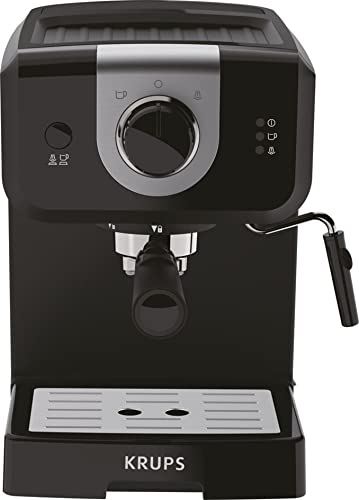How to Maintain Espresso Machines
Espresso drinks can be beneficial to businesses like hair salons, doctors offices, and even car dealerships. The availability of these delicious drinks will increase the patience of customers when they wait for services and enhance the atmosphere of your establishment.
This nifty machine is which was a Good Housekeeping 2022 Espresso winner, uses smart dosing to measure and distribute the ideal amount of coffee ground for each shot. It also comes with a milk frother that was a success in our tests.
The Basics
Espresso machines can be a great addition to any office or home. They can be used for numerous drinks, including cappuccinos or lattes. espresso coffee machines work by pushing hot water through ground coffee under pressure. This results in a concentrated shot of coffee that is extremely flavorful. It has a significant amount of caffeine, which is an effective stimulant.
These kinds of machines are available in a variety of sizes ranging from small models that are perfect for residential use to larger models designed for commercial use. They are available in both manual and semi-automatic designs. Semi-automatic machines have an inbuilt pump that regulates the water's flow and pressure. Manual machines require you to manage this manually. Some semi-automatic models include grinders, whereas others do not. The kind of machine you select will be based on your personal preferences and budget.
The manual espresso machine operates by turning a handle, which forces water through the grounds inside a filter basket. This type of machine is often called caffettiera or macchinetta and it is the most popular type of espresso maker. It features the bottom chamber, which holds the water, and a top chamber that has an iron filter. When heated, the steam is pushed through the coffee grounds and into the top of the machine, where the espresso is ready to serve.
Variety
Depending on your preferences depending on your needs, you can select from a range of espresso machines. There are semi-automatic, manual, and fully automatic espresso machines. Each machine has its own distinctive method of making espresso shots, as well as other beverages like lattes and cappuccinos.
The first machines were not fully automated, and required the user to operate the lever manually that produced the pressure needed to brew a shot espresso. These machines are still available but they aren't as widespread due to the work required and the stress they can cause. Modern espresso machines make use of various mechanisms to create pressure which includes push, screw and see-saw designs. This allows the user to regulate the amount of pre-infusion more precisely than the lever machine.

A pump-driven espresso machine is akin to the stovetop moka pot however, it uses an electric pump instead of steam to press the grounds. The boiler heats water to boiling point, and a pump then pushes the water through an affluent head. These are the most popular types of espresso machines and are generally less expensive than other types.
Semi-automatic espresso machine combine the best features of pump-driven and manual espresso machines. They allow the user to grind and tamp the beans, but a motor regulates the pressure to ensure consistent extraction. They also have a separate chamber that is heated and froths milk and some come with a built-in grinder.
Functions
Commercial espresso machines create a variety of espressos and coffees with the push of the button. They make use of pre-packaged espresso pods that are precisely dosed and packaged to make an espresso cup or coffee. These machines are streamlined and remove the need for grinders, dosing, and tamping, making them popular for busy offices. Since they don't have steam functions, a separate milk froth is required to make cappuccinos and lattes.
Many cafes in Europe employed steam machines to boost production and reduce brewing times. The first machines were heated with an open flame, resulting in uneven pressure and temperature. The inventor Angelo Moriondo of Turin, Italy is credited with developing the first machine capable of making espresso without steam.
The most well-known model today is the pump-driven espresso machine. These machines use a portafilter to hold the ground espresso beans. When the valve is adjusted to the espresso position the water is pumped under 15 atmospheres of pressure from the heating vessel. When the brew cycle is complete, the portafilter is removed and the drip tray emptied to be cleaned.
Automated espresso machines are semi-automatic systems, by controlling the extraction time based on internal or volumetric timers. They also eliminate the barista’s ability to tamp or grind coffee, which may affect the quality of the final product.
Maintenance
Espresso machines aren't the most attractive item in a coffee shop, but they are vital. The way you maintain the espresso machine will impact the quality and taste of your drinks.
A clean espresso machine ensures that the taste of your coffee will not be ruined and your customers' experience will be great. Regularly scheduled cleanings can extend the lifespan of your espresso machine.
Make use of a damp cloth and clean the baskets and portafilters each shift to get rid of any residue or oil. Backflush the gasket between the portafilter head as well as the grouphead by inserting the nylon brush and moving it to eliminate any buildup. Rinse the gasket with water and then run it through again until water runs clear.
Mix espresso machine cleaner with water in a container according to the directions of the manufacturer once a week, or as required. Then soak the portafilters grates, and baskets for a night in the cleaning solution. If your espresso machine is equipped with a steam wand as well as a screen, remove them from the collection using the screwdriver. In separate soaking, soak them in the cleaning solution.
